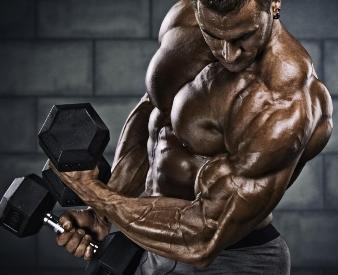Understand the effects of endogenous testosterone (produced naturally by the body) and exogenous testosterone (an artificial form administered as a supplement).
Testosterone is the male sex hormone. In man, its production is made mostly by the testes, while in women small amounts are produced by the ovaries and the adrenal gland.
Testosterone plays a key role in the health and development of man throughout his life, from the fetal to the old age.
Most of the characteristics that make a male of the human species look like a man comes from the action of testosterone in the body, including the greater presence of body hair, thicker voice, greater muscle mass, greater stature, development of the penis and testicles, etc.
Due to its positive effect on muscle anabolism, from the mid-twentieth century, testosterone has been used as a supplement for athletes seeking better sports performance and for people wishing to increase their muscle mass.

Unfortunately, the anabolic action of testosterone is always accompanied by an androgenic (masculinizing) effect, which when present in excess can bring several health problems, as we will see later.
In this article we will address the following points.
• What is testosterone.
• What are the male hormones for?
• What happens when there is a lack of testosterone.
• Testosterone replacement to treat hypogonadism.
• Anabolic androgenic steroids.
• Adverse effects of testosterone supplementation.
• Diseases that cause elevated testosterone.
What is testosterone
Testosterone is an anabolic androgenic steroid hormone , that is, a lipid synthesized from cholesterol (steroid), produced by glands and with regulatory action in cellular physiology (hormone), whose main actions are to promote masculinization (androgenic effect) and the synthesis of complex molecules from simpler molecules (anabolic effect).
The three main steroid substances produced by our body are androgens, estrogens and corticosteroids.
Androgens, whose main representative is testosterone, are responsible for the development of male characteristics. Estrogens are the hormones responsible for the development of female characteristics. Corticosteroids are responsible for a variety of functions essential to our body, which involve the immune, cardiovascular, metabolic and hemostatic systems.
Women produce a large amount of estrogen through the ovaries and a small amount of testosterone in the adrenal gland and the ovaries. On the other hand, men produce a large amount of testosterone in the testicles and a small amount of estrogen in the liver, in the fatty tissue and in the brain.
The production of testosterone by the testicles is stimulated by LH (luteinizing hormone), which is a hormone produced by the pituitary gland, a gland in the brain. Every time the pituitary gland increases LH release, the testes respond by increasing testosterone production.
In men, testosterone production peaks in three distinct phases of life. The first peak occurs during the fetal period, in the second trimester of pregnancy, and aims to develop the fetus with male physical characteristics.
Subsequently, even in the first year of the boys’ life, testosterone rises again, but no clear effect on the baby’s body is perceived. It is thought that this peak serves to “masculinize” the boys’ brains, shaping some behaviors that are characteristic of the male sex.
The third peak, which is most obvious, occurs during puberty, resulting in several visible changes, such as altered voice, increased body hair, genital maturation, sperm production by the testicles, thicker, oily skin, increased libido, bone growth, increased muscle mass and reduced body fat.
Lack of testosterone
The normal blood level of testosterone in adult males is 240-950 ng / dL (the reference value may vary slightly depending on the laboratory).
From the age of 40, the natural production of testosterone begins to fall at a rate of approximately 1% per year.
In some men, this rate of fall is greater, making them reach 60-70 years with a relevant deficiency of testosterone, which is a picture analogous to that occurring in menopausal women, called andropause or late male hypogonadism.
Hypogonadism is a problem that arises whenever the body can not produce adequate amounts of testosterone, either because of a problem with the testes or because the pituitary gland can not produce adequate levels of LH.
Hypogonadism does not only appear in elderly patients, it may be present from the fetal life, as in cases of hypogonadism of genetic origin, or during pre-adolescence, which can be caused by various diseases or drug use.
When hypogonadism occurs in the fetus, malformations of the genitalia are common. When it occurs in pre-adolescents, the patient does not enter puberty and does not develop the secondary sexual characteristics that usually arise during this period.
When hypogonadism occurs in adult males, the symptoms are less clear and may be confused with the natural aging process. Some examples:
• Reduced libido.
• Erectile dysfunction .
• Loss of bone mass.
• Reduction of muscle mass.
• Increased body fat percentage.
• Humor depression.
• Memory changes.
• Fall of performance at work
Testosterone Supplementation
The use of testosterone supplements is usually used by men who have some degree of hypogonadism or want to increase their athletic performance, either for better sports results or simply to facilitate the gain of muscle mass.
Supplementation for older men with suspected andropause is still a controversial subject. Currently, supplementation is only indicated if the patient has relevant symptoms of hypogonadism and low testosterone (less than 200 ng / dL) blood levels measured at three different times during the morning.
There are several synthetic testosterone options on the market, ranging from injections, to gels and skin patches. Some examples:
• Durateston (testosterone propionate, testosterone phenylpropionate, testosterone decanoate and testosterone isocaproate) → 250 mg ampoules for intramuscular administration every 3 weeks.
• Nebido (Testosterone Undecilate) → 1000 mg ampoules for intramuscular administration every 10 to 14 weeks.
• Deposteron (testosterone cypionate) → 200 mg ampoules for intramuscular administration each week.
• Androxon (Testosterone Undecilate) → 40 mg capsules for oral administration, 2 to 4 capsules per day divided into 2 daily doses.
• Axeron (testosterone) → topical solution with application pump (3mg / 1.5ml) for underarm application of 30 to 120mg per day.
• AndroGel (testosterone) → 1% gel with 50 mg envelopes for application to the skin of the shoulders, arms or abdomen daily.
Testosterone as anabolic steroid
Individuals who use testosterone supplements as a means to gain muscle mass faster or to improve their athletic performance wish to have the anabolic effects with the least possible androgenic effects.
In general, the major anabolic steroids are not made up of testosterone itself, but rather by precursors or derivatives of testosterone.
Some of the best known androgenic anabolic steroids are:
• Nandrolone Decanoate (Deca-Durabolin).
• Estanozolol (Winstrol or Winstrol Depot).
• Androstenedione (Andro).
• Dehydroepiandrosterone (DHEA).
• Oxandrolone (Anavar).
• Oxymetholone (Anadrol-50 or Hemogenin).
• Dihydrotestosterone (DHT).
• Methandrostenolone (Dianabol).
• Fluoxymesterone (Halotestin).
• Metenolone Enanthate (Primobolan).
• Trenbolone (Fina).
High doses of some androgenic hormones also cause increased levels of estrogen, as part of the excess testosterone is converted into a female hormone.
To avoid side effects associated with increased estrogen, some people associate anti-estrogenic drugs, such as tamoxifen, with the use of anabolic steroids.
Adverse effects of testosterone
Supplementing testosterone or its derivatives, either as a treatment for hypogonadism or as an anabolic drug, can lead to a number of complications, especially if taken in high doses for a long time.
The main possible side effects associated with the use of androgenic hormones are:

• Elevation of cholesterol .
• Hypertension .
• Cardiac hypertrophy.
• Increased risk of acute myocardial infarction .
• Fluid retention .
• Increased oiliness of the skin.
• Bad odor .
• Acne .
• Baldness .
• Reduction in sperm production.
• Gynecomastia (breast growth in men).
• Increased prostate volume.
• Increased risk of prostate cancer .
• Interruption of growth in adolescents.
• Medicated hepatitis .
• Testicular atrophy.
Collating effects on women
For obvious reasons, the adverse effects of androgen anabolics are much more common and intense in women than in men, especially in the aesthetic part.
Among the most relevant effects are:
• Increased hairs on the body and face.
• Hoarseness of voice.
• Hypertrophy of the clitoris.
• Menstrual changes.
• Infertility.
• Baldness.
• Atrophy of the breasts.
• Acne.
Naturally high levels of testosterone
Some patients, both men and women, can have high levels of testosterone naturally, without the influence of supplements.
In general, this is a sign of some disease that is stimulating the production of androgens. The main causes are:
• Testicular cancer
• Cancer of the adrenal gland
• Ovarian cancer
• Polycystic ovarian syndrome
I enjoy writing a newsworthy story, create interesting articles and hunt down experts for interviews which can be challenging for most freelance writers. Now add a visual impairment to those challenges and see what you get!